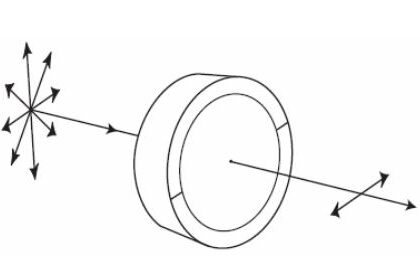Birefringent polarisers transmits the desired polarisation and scatters/deviate’s the rest. This utilises the fundamental property of birefringence, where the refractive index depends on its polarisation.
Commonly in the form of joined prisms this type of polariser offers higher extinction ratios, higher damage thresholds, broad wavelength ranges but are more expensive.
Beam-splitting Polarising Prisms
Part codes ending in ‘B’ are α-BBO crystal type usable in the ultraviolet region and ‘C’ are Calcite based usable in the visible to the infrared region
Glan Laser (GLPB/GLPC)
The Glan Laser polariser contain two prisms with a small gap (air-gap) to eliminate the adhesive and reduce laser damage. Suitable for high power lasers and high energy laser pulses. Housed in a metal frame. The polarisation component which does not pass through the prism exits out of the frame through port (hole). Since there are two ports, the prism can also be used by replacing the input and output direction.
Glan Taylor (GYPB/GYPC)
Similar to the Glan Laser where the two prisms are mounted with a small gap (air-gap) to eliminate the adhesive and reduce laser damage, but smaller in length. Light not transmitted through the Gran Taylor prism is absorbed and scattered in all side faces of the prism, so more suitable for medium power lasers
Glan Thompson (GTPB/GTPC)
Applicable for low powers, ideal for UV, visible or NIR applications. The two prisms are cemented allowing for a wider field of view. Used for Laser, microscopy and imaging applications
Roshon (RSPCQ/RSPMF)
The polarizer separates the incident light into two linearly polarized lights that cross perpendicular. It corresponds to the wide wavelength range from ultraviolet to infrared. P polarized light is emitted straight without the displacement from the optical path, and S-polarized light is emitted with a separation angle.
Wollaston (WPPB/WPPC)
It is a prism for separating the incident beam into two linearly polarized beams with orthogonal polarising direction. Broadband operating over a wavelength range of 190 – 3500nm. Used in optical systems where both polarisations need to be accessed such as phase-contrast microscopes


































